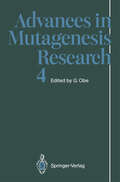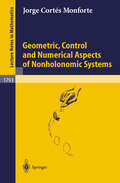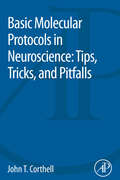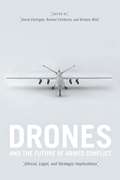- Table View
- List View
Molecular Immunotoxicology
by Emanuela Corsini Henk Van LoverenThe human immune system is constantly exposed to chemical contaminants, whether from food, water or air. Some chemicals directly elicit an immune response, while others indirectly activate or deactivate components within the immune system. Thus when tracking or predicting the effect of a chemical on the immune system, many different pathways and modes of action need to be considered. Following an introduction to the various pathways and toxicity mechanisms from a systemic perspective, the main part of this comprehensive reference surveys individual molecular mechanisms of important immunotoxicants, from PAHs to biopharmaceuticals, and from receptor-mediated toxicity to nanoparticle toxicity, using analyses based on molecular effects rather than on animal models. Taken together, the knowledge presented here provides an up-to-date overview of this hot topic that can be directly applied to the prediction and characterization of immunotoxic effects in drugs, chemicals, and environmental contaminants.
Hereditary Gastric and Breast Cancer Syndrome: CDH1: One Genotype with Multiple Phenotypes
by Giovanni Corso Paolo Veronesi Franco RovielloIn this book the editors and authors provide a comprehensive overview on basic research and clinical aspects of hereditary breast and gastric tumors. In particular, this updated editorial work aims to suggest guidelines for the clinical management of patients with hereditary diffuse gastric and lobular breast cancer. Special attention is given to E-cadherin (CDH1 gene) germline mutations, genetic screening approaches, the underlying molecular mechanisms and pathological and microscopic features. In addition, the book aims to define clinical criteria for genetic screening, and highlights current surgical treatment and clinical approaches for asymptomatic mutation carriers. Other inherited predispositions involving gastric and breast carcinoma are discussed as well. Divided into eight sections, the book starts by providing an epidemiological overview of gastric and breast cancers, followed by a section dealing with new descriptions of genetic pathways in hereditary cancer predispositions. The third section focuses on pathological features of the diseases, in an effort to bridge the gap between discovery and cancer therapy development. Subsequent sections of the book are dedicated to endoscopy and breast imaging, as well as risk-reducing surgeries to curb the risk of developing cancer. The sixth section focuses on the generation of ideas for the identification of targets and novel treatment strategies. Finally, in the seventh section the authors share the story of two patients and their experiences with the diagnosis and treatment of hereditary cancer.This multidisciplinary book brings together multiple disciplines in science and technology; specifically, medicine, surgery and biology. The majority of authors are members of the International Gastric Cancer Linkage Consortium (IGCLC) and of the European Cancer Prevention Organization (EJCPO), with relevant experience in this context. Offering in-depth insights into hereditary cancers, this book represents essential reading for students, researchers, and specialists who want to extend their knowledge on hereditary gastric and breast cancers.
Corridors of Power: The Politics of Environmental Aid to Madagascar (Yale Agrarian Studies Series)
by Catherine A. CorsonA highly regarded academic and former policy analyst and consultant charts the forty-year history of neoliberalism, environmental governance, and resource rights in Madagascar Since the 1970s, the U.S. Agency for International Development has spent millions of dollars to preserve Madagascar’s rich biological diversity. Yet its habitats are still in decline. Studying forty years of policy making in multiple sites, Catherine Corson reveals how blaming impoverished Malagasy farmers for Madagascar’s environmental decline has avoided challenging other drivers of deforestation, such as the logging and mining industries. In this important ethnographic study, Corson reveals how Madagascar’s environmental program reflects the transformation of global environmental governance under neoliberalism.
The Bluefin Tuna Fishery in the Bay of Biscay: Its Relationship with the Crisis of Catches of Large Specimens in the East Atlantic Fisheries from the 1960s (SpringerBriefs in Biology)
by José Luis Cort Pablo AbaunzaThis open access book is an original contribution to the knowledge on fishing and research associated with one of the most enigmatic fish of our seas: bluefin tuna, Thunnus thynnus (L.). Based on available evidence, it reconstructs the possible methods used to catch large spawners in the Strait of Gibraltar thousands of years ago and describes the much more recent overfishing that led to a great reduction in the catches of the trap fishery on the area and the disappearance of the northern European fisheries. It is the first book to relate the overfishing of juvenile fishes in certain areas to the decline of large spawners in other very distant areas, revealing one of the main underlying causes of this decline, which has remained a mystery to the fishing sector and scientists alike for over 50 years. This finding should serve to prevent similar cases from arising in the future.
Second Bibliographic Guide to the History of Computing, Computers, and the Information Processing Industry (Bibliographies and Indexes in Science and Technology)
by James W. CortadaComplementing the author's 1990 bibliography, A Bibliographic Guide to the History of Computing, Computers, and the Information Processing Industry, this bibliography provides 2,500 new citations, covering all significant literature published since the late 1980s. It includes all aspects of the subject—biographies, company histories, industry studies, product descriptions, sociological studies, industry directories, and traditional monographic histories—and covers all periods from the beginnings to the personal computer. New to this volume is a chapter on the management of information processing operations, useful to both historians and managers of information technology. Together with the earlier bibliography, this work provides the most comprehensive bibliographic guide to the history of computers, computing, and the information processing industry.The organization of the book follows that of the earlier work, with the addition of the new chapter on the management of information processing. All entries are new to this volume. Titles are annotated, and each chapter begins with a short introduction. A full table of contents and author and subject indexes enhance accessibility to the material.
Protein-based Engineered Nanostructures (Advances in Experimental Medicine and Biology #940)
by Aitziber L. Cortajarena Tijana Z. GroveThis book is devoted to the engineering of protein-based nanostructures and nanomaterials. One key challenge in nanobiotechnology is to be able to exploit the natural repertoire of protein structures and functions to build materials with defined properties at the nanoscale using “bottom-up” strategies. This book addresses in an integrated manner all the critical aspects that need to be understood and considered to design the next generation of nano-bio assemblies. The book covers first the fundamentals of the design and features of the protein building blocks and their self-assembly illustrating some of the most relevant examples of nanostructural design. Finally, the book contains a section dedicated to demonstrated applications of these novel bioinspired nanostructures in different fields from hybrid nanomaterials to regenerative medicine. This book provides a comprehensive updated review of this rapidly evolving field.
Computational Systems Biology in Medicine and Biotechnology: Methods And Protocols (Methods In Molecular Biology Ser. #2399)
by Sonia Cortassa Miguel A. AonComputational Systems Biology in Medicine and Biotechnology: Methods and Protocols (Methods in Molecular Biology #2399)
by Sonia Cortassa Miguel A. AonThis volume addresses the latest state-of-the-art systems biology-oriented approaches that--driven by big data and bioinformatics--are utilized by Computational Systems Biology, an interdisciplinary field that bridges experimental tools with computational tools to tackle complex questions at the frontiers of knowledge in medicine and biotechnology. The chapters in this book are organized into six parts: systems biology of the genome, epigenome, and redox proteome; metabolic networks; aging and longevity; systems biology of diseases; spatiotemporal patterns of rhythms, morphogenesis, and complex dynamics; and genome scale metabolic modeling in biotechnology. In every chapter, readers will find varied methodological approaches applied at different levels, from molecular, cellular, organ to organisms, genome to phenome, and health and disease. Written in the highly successful Methods in Molecular Biology series format, chapters include introductions to their respective topics; criteria utilized for applying specific methodologies; lists of the necessary materials, reagents, software, databases, algorithms, mathematical models, and dedicated analytical procedures; step-by-step, readily reproducible laboratory, bioinformatics, and computational protocols all delivered in didactic and clear style and abundantly illustrated with express case studies and tutorials; and tips on troubleshooting and advice for achieving reproducibility while avoiding mistakes and misinterpretations. The overarching goal driving this volume is to excite the expert and stimulate the newcomer to the field of Computational Systems Biology.Cutting-edge and authoritative, Computational Systems Biology in Medicine and Biotechnology: Methods and Protocols is a valuable resource for pre- and post-graduate students in medicine and biotechnology, and in diverse areas ranging from microbiology to cellular and organismal biology, as well as computational and experimental biologists, and researchers interested in utilizing comprehensive systems biology oriented methods.
Advances in Mutagenesis Research (Advances in Mutagenesis Research #4)
by F. Cortes P. Escalza A. Hofmann V. I. Ivanov H. Kasai G. Klopman G. Korge N. A. Liapunova S. Nishimura N. Paweletz B. Richards H. S. Rosenkranz M. Ruiz-Rubio M. M. Shahin B. K. Vig R. D. Wegner D. WildMathematical Analysis and Simulation of Field Models in Accelerator Circuits (Springer Theses)
by Idoia Cortes GarciaThis book deals with the analysis and development of numerical methods for the time-domain analysis of multiphysical effects in superconducting circuits of particle accelerator magnets. An important challenge is the simulation of “quenching”, i.e. the transition of a material from the superconducting to the normally electrically conductive state. The book analyses complex mathematical structures and presents models to simulate such quenching events in the context of generalized circuit elements. Furthermore, it proposes efficient parallelized algorithms with guaranteed convergence properties for the simulation of multiphysical problems. Spanning from theoretical concepts to applied research, and featuring rigorous mathematical presentations on one side, as well as simplified explanations of many complex issues, on the other side, this book provides graduate students and researchers with a comprehensive introduction on the state of the art and a source of inspiration for future research. Moreover, the proposed concepts and methods can be extended to the simulation of multiphysical phenomena in different application contexts.
Geometric, Control and Numerical Aspects of Nonholonomic Systems (Lecture Notes in Mathematics #1793)
by Jorge Cortés MonforteNonholonomic systems are a widespread topic in several scientific and commercial domains, including robotics, locomotion and space exploration. This work sheds new light on this interdisciplinary character through the investigation of a variety of aspects coming from several disciplines. The main aim is to illustrate the idea that a better understanding of the geometric structures of mechanical systems unveils new and unknown aspects to them, and helps both analysis and design to solve standing problems and identify new challenges. In this way, separate areas of research such as Classical Mechanics, Differential Geometry, Numerical Analysis or Control Theory are brought together in this study of nonholonomic systems.
Metal-Organic Frameworks in Biomedical and Environmental Field
by Patricia Horcajada Cortés Sara Rojas MacíasThis book joins an international and interdisciplinary group of leading experts on the biomedical, energy and environmental applications of Metal-Organic Frameworks (MOFs). The resulting overview covers everything from the environmentally friendly and scale up synthesis of MOFs, their application in green energy generation and storage, and water purification to their use as drug delivery systems, biosensors, and their association with relevant macromolecules (genes, enzymes). This book is focused on the interest of MOFs in applications such as the leading –edge environmental (energy-related) and biomedical fields. The potential of MOFs in these areas is currently progressing at a fast pace, since the wide possibilities that MOFs offer in terms of composition, topology, incorporation of active species (in their porosity, on their external surface or within the framework), and post-synthetic modifications, among others. The aim here is to provide future research goals that emphasize relevant nuances to this class of materials as a whole.
Mathematical Methods of Classical Physics (SpringerBriefs in Physics)
by Vicente Cortés Alexander S. HauptThis short primer, geared towards students with a strong interest in mathematically rigorous approaches, introduces the essentials of classical physics, briefly points out its place in the history of physics and its relation to modern physics, and explains what benefits can be gained from a mathematical perspective.As a starting point, Newtonian mechanics is introduced and its limitations are discussed. This leads to and motivates the study of different formulations of classical mechanics, such as Lagrangian and Hamiltonian mechanics, which are the subjects of later chapters.In the second part, a chapter on classical field theories introduces more advanced material. Numerous exercises are collected in the appendix.
Basic Molecular Protocols in Neuroscience: Tips, Tricks, And Pitfalls
by John T. CorthellBasic Neuroscience Protocols: Tips, Tricks, and Pitfalls contains explanatory sections that describe the techniques and what each technique really tells the researcher on a scientific level. These explanations describe relevant controls, troubleshooting, and reaction components for some of the most widely used neuroscience protocols that remain difficult for many neuroscientists to implement successfully. Having this additional information will help researchers ensure that their experiments work the first time, and will also minimize the time spent working on a technique only to discover that the problem was them, and not their materials.Describes techniques in very specific detail with step-by-step instructions, giving researchers in-depth understandingOffers many details not present in other protocol booksDescribes relevant controls for each technique and what those controls meanChapters include references (key articles, books, protocols) for additional studyDescribes both the techniques and the habits necessary to get quality results, such as aseptic technique, aliquoting, and general laboratory rules
Direct Alcohol Fuel Cells: Materials, Performance, Durability and Applications
by Horacio R. Corti Ernesto R. GonzalezDirect Alcohol Fuel Cells: Materials, Performance, Durability and Applications begins with an introductory overview of direct alcohol fuel cells (DAFC); it focuses on the main goals and challenges in the areas of materials development, performance, and commercialization. The preparation and the properties of the anodic catalysts used for the oxidation of methanol, higher alcohols, and alcohol tolerant cathodes are then described. The membranes used as proton conductors in DAFC are examined, as well as alkaline membranes, focusing on the electrical conductivity and alcohol permeability. The use of different kinds of carbon materials as catalyst supports, gas diffusion layers, and current collectors in DAFC is also discussed. State of the art of the modeling is used to estimate performance and durability. The closing chapter reviews the use of DAFC in portable equipment and mobile devices and features a detailed discussion on the mechanisms of component degradation which limits their durability.This book is written to facilitate the understanding of DAFC technology, applications, and future challenges. It is an excellent introduction for electrochemical and material engineers interested in small fuel cells as portable energy sources, scientists focused on materials science for energy production and storage, as well as policy-makers in the area of renewable energies.
Trends in Colloid and Interface Science V (Progress in Colloid and Polymer Science #84)
by M. Corti F. MallamaceWomen and Teaching: Global Perspectives on the Feminization of a Profession
by R. Cortina S. San Román Sonsoles San RománThis unique volume addresses issues of gender in education by examining the work experiences and policies affecting women and teaching in Latin America, North America and parts of Europe, with a focus on the social construction of women teachers.
Drones and the Future of Armed Conflict: Ethical, Legal, and Strategic Implications
by David Cortright Rachel Fairhurst Kristen WallDuring the past decade, armed drones have entered the American military arsenal as a core tactic for countering terrorism. When coupled with access to reliable information, they make it possible to deploy lethal force accurately across borders while keeping one’s own soldiers out of harm’s way. The potential to direct force with great precision also offers the possibility of reducing harm to civilians. At the same time, because drones eliminate some of the traditional constraints on the use of force—like the need to gain political support for full mobilization—they lower the threshold for launching military strikes. The development of drone use capacity across dozens of countries increases the need for global standards on the use of these weapons to assure that their deployment is strategically wise and ethically and legally sound. Presenting a robust conversation among leading scholars in the areas of international legal standards, counterterrorism strategy, humanitarian law, and the ethics of force, Drones and the Future of Armed Conflict takes account of current American drone campaigns and the developing legal, ethical, and strategic implications of this new way of warfare. Among the contributions to this volume are a thorough examination of the American government’s legal justifications for the targeting of enemies using drones, an analysis of American drone campaigns’ notable successes and failures, and a discussion of the linked issues of human rights, freedom of information, and government accountability.
Drones and the Future of Armed Conflict: Ethical, Legal, and Strategic Implications
by David Cortright Rachel Fairhurst Kristen WallDuring the past decade, armed drones have entered the American military arsenal as a core tactic for countering terrorism. When coupled with access to reliable information, they make it possible to deploy lethal force accurately across borders while keeping one’s own soldiers out of harm’s way. The potential to direct force with great precision also offers the possibility of reducing harm to civilians. At the same time, because drones eliminate some of the traditional constraints on the use of force—like the need to gain political support for full mobilization—they lower the threshold for launching military strikes. The development of drone use capacity across dozens of countries increases the need for global standards on the use of these weapons to assure that their deployment is strategically wise and ethically and legally sound. Presenting a robust conversation among leading scholars in the areas of international legal standards, counterterrorism strategy, humanitarian law, and the ethics of force, Drones and the Future of Armed Conflict takes account of current American drone campaigns and the developing legal, ethical, and strategic implications of this new way of warfare. Among the contributions to this volume are a thorough examination of the American government’s legal justifications for the targeting of enemies using drones, an analysis of American drone campaigns’ notable successes and failures, and a discussion of the linked issues of human rights, freedom of information, and government accountability.
Drones and the Future of Armed Conflict: Ethical, Legal, and Strategic Implications
by David Cortright Rachel Fairhurst Kristen WallDuring the past decade, armed drones have entered the American military arsenal as a core tactic for countering terrorism. When coupled with access to reliable information, they make it possible to deploy lethal force accurately across borders while keeping one’s own soldiers out of harm’s way. The potential to direct force with great precision also offers the possibility of reducing harm to civilians. At the same time, because drones eliminate some of the traditional constraints on the use of force—like the need to gain political support for full mobilization—they lower the threshold for launching military strikes. The development of drone use capacity across dozens of countries increases the need for global standards on the use of these weapons to assure that their deployment is strategically wise and ethically and legally sound. Presenting a robust conversation among leading scholars in the areas of international legal standards, counterterrorism strategy, humanitarian law, and the ethics of force, Drones and the Future of Armed Conflict takes account of current American drone campaigns and the developing legal, ethical, and strategic implications of this new way of warfare. Among the contributions to this volume are a thorough examination of the American government’s legal justifications for the targeting of enemies using drones, an analysis of American drone campaigns’ notable successes and failures, and a discussion of the linked issues of human rights, freedom of information, and government accountability.
Annual Plant Reviews, Plant Systems Biology (Annual Plant Reviews)
by Gloria Coruzzi Rodrigo GutiérrezPlant Systems Biology is an excellent new addition to the increasingly well-known and respected Annual Plant Reviews. Split into two parts, this title offers the reader: A fundamental conceptual framework for Systems Biology including Network Theory The progress achieved for diverse model organisms: Prokaryotes, C. elegans and Arabidopsis The diverse sources of “omic” information necessary for a systems understanding of plants Insights into the software tools developed for systems biology Interesting case studies regarding applications including nitrogen-use, flowering-time and root development Ecological and evolutionary considerations regarding living systems This volume captures the cutting edge of systems biology research and aims to be an introductory material for undergraduate and graduate students as well as plant and agricultural scientists, molecular biologists, geneticists and microbiologists. It also serves as a foundation in the biological aspects of the field for interested computer scientists. Libraries in all universities and research establishments where biological and agricultural sciences are studied and taught and integrated with Computer Sciences should have copies of this important volume on their shelves.
Plant Molecular Biology: Molecular Genetic Analysis of Plant Development and Metabolism (Nato ASI Subseries H: #81)
by Gloria Coruzzi Pere PuigdomenechPresented here is an analysis of plant development and plant metabolism using the tools of genetics and molecular biology, such as mutant analysis, mutation tagging, mapping using polymorphic characters and basic molecular biology techniques. Studies with a range of model genetic organisms, most notably maize and Arabidopsis, are included. The reader gains a comprehensive view of the subject which is more and more of both scientific and industrial interest. The value of basic research in plants is highlighted and examples where basic studies have led to applications in agricultural biotechnology are given.
The World of Galaxies: Proceedings of the Conference “Le Monde des Galaxies” Held 12–14 April 1988 at the Institut d’Astrophysique de Paris in Honor of Gérard and Antoinette de Vaucouleurs on the Occasion of His 70th Birthday
by Harold G. Corwin Lucette BottinelliFrom 12 April to 14 April 1988, 120 of Gerard and Antoinette de Vaucouleurs's friends and colleagues gathered at the Institut d' Astrophysique in Paris to cel ebrate Gerard's 70th birthday and his remarkable career in Astronomy. The gathering also honored the memory of Antoinette (who died 29 August 1987 after a long illness) and her own no less remarkable career. This volume collects the 24 invited review papers and the 60 contributed poster papers presented at the meeting. Gerard de Vaucouleurs Gerard de Vaucouleurs was born on 25 April 1918 in Paris, where he spent his boyhood. He became an active amateur astronomer in the early 1930's, making extensive observations of Mars, Jupiter, and variable stars (including the bright supernova of 1937 in IC 4182). He also began life-long interests in astronomical photography and galaxy cataloguing during this period. In 1939, he met the director of the Paris transport system and an equally avid amateur astronomer, Julien Peridier. De Vaucouleurs worked at Peridier's private observatory at Le Houga in southwestern France on and off throughout the next decade. His undergraduate work was in mathematics, astronomy, and experimental physics; this, combined with his interest in observational astronomy, formed his life-long empirical approach to science. After spending 18 months in the French army early in 1939 - 41, Gerard returned to the Peridier observatory and then, in 1943, to his studies at the Sorbonne, where he met Antoinette.
The Reciprocal Modular Brain in Economics and Politics: Shaping the Rational and Moral Basis of Organization, Exchange, and Choice
by Gerald A. Cory Jr.The present work is an extension of my doctoral thesis done at Stanford in the early 1970s. In one clear sense it responds to the call for consilience by Edward O. Wilson. I agree with Wilson that there is a pressing need in the sciences today for the unification of the social with the natural sciences. I consider the present work to proceed from the perspective of behavioral ecology, specifically a subfield which I choose to call interpersonal behavioral ecology th Ecology, as a general field, has emerged in the last quarter of the 20 century as a major theme of concern as we have become increasingly aware that we must preserve the planet whose limited resources we share with all other earthly creatures. Interpersonal behavioral ecology, however, focuses not on the physical environment, but upon our social environment. It concerns our interpersonal behavioral interactions at all levels, from simple dyadic one-to-one personal interactions to our larger, even global, social, economic, and political interactions. Interpersonal behavioral ecology, as I see it, then, is concerned with our behavior toward each other, from the most obvious behaviors of war between nations, to excessive competition, exploitation, crime, abuse, and even to the ways in which we interact with each other as individuals in the family, in our social lives, in the workplace, and in the marketplace.





















